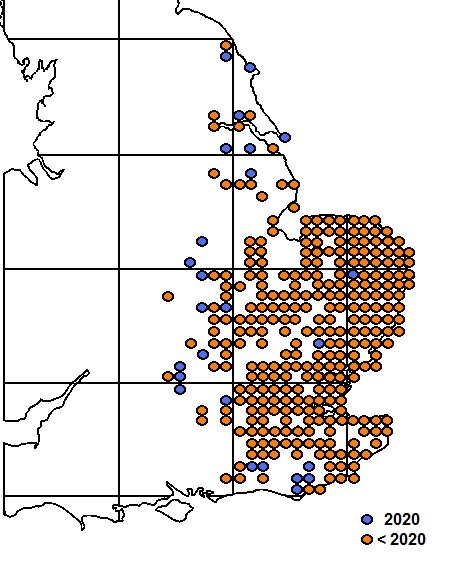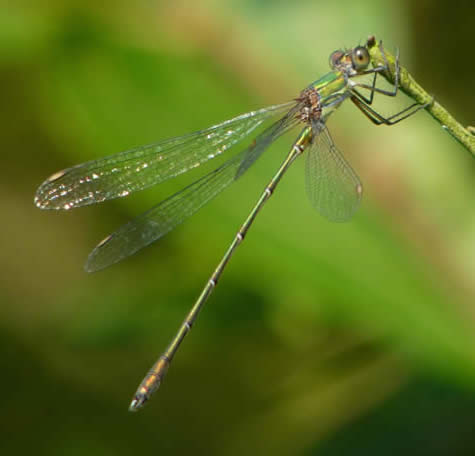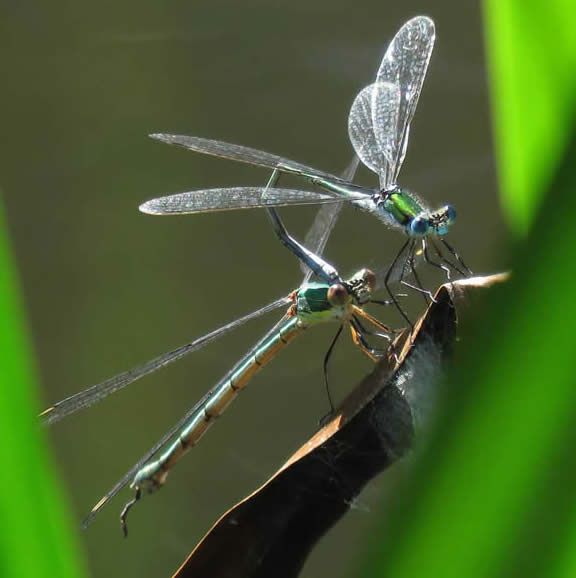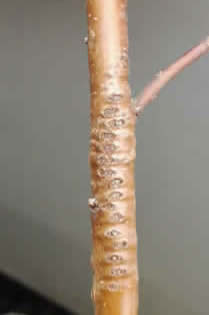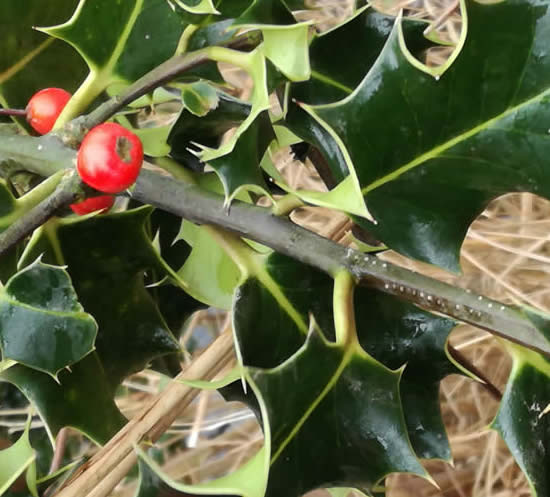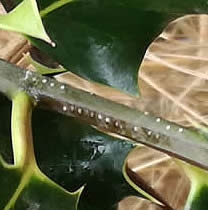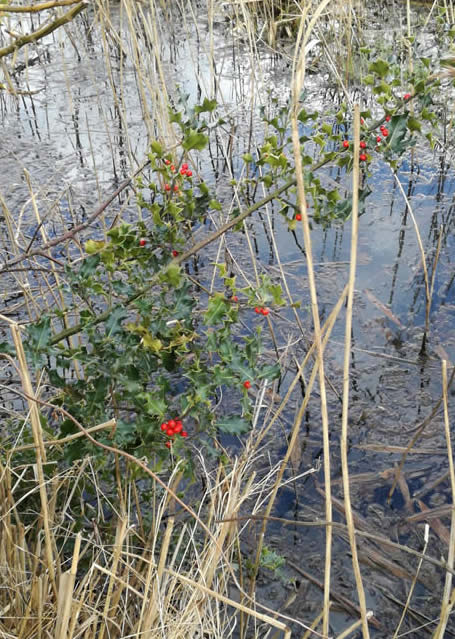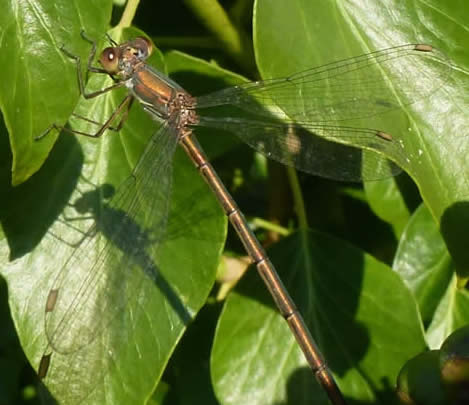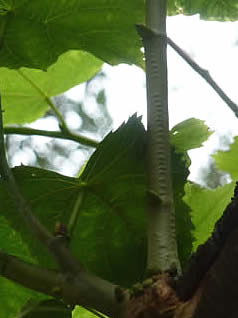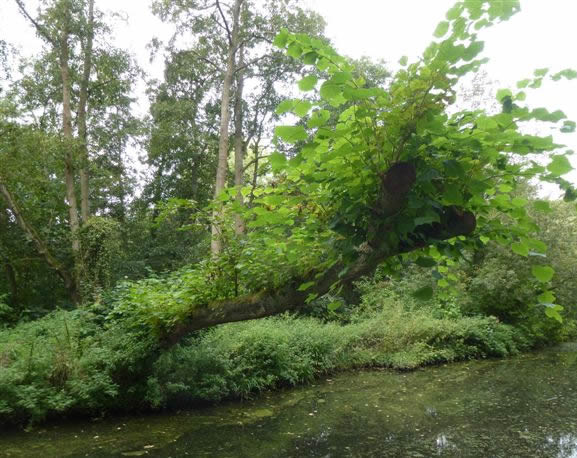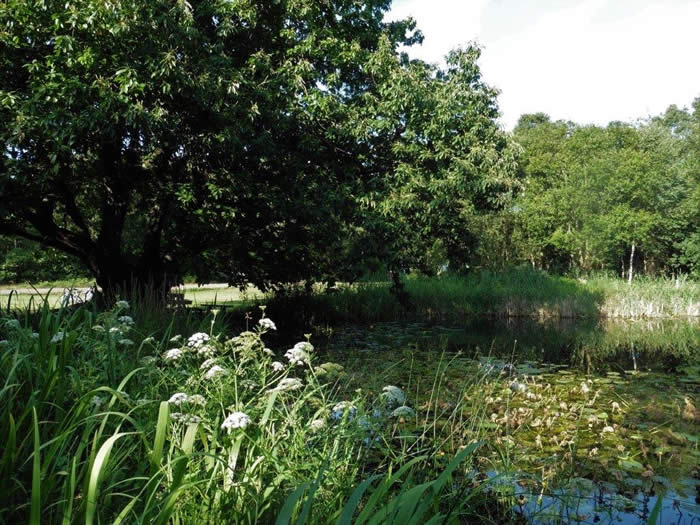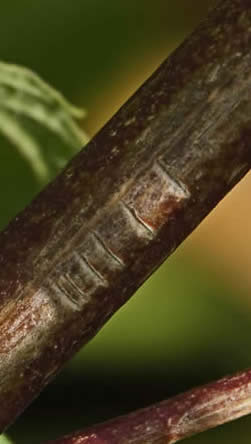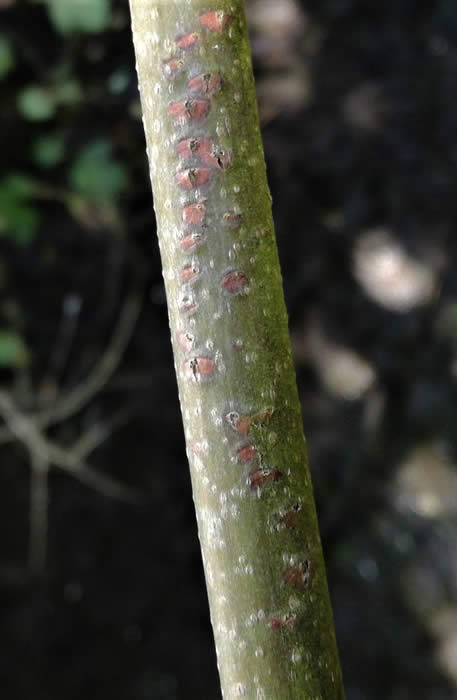Willow Emerald Damselflies
New tree and shrub species with egg-laying scars
This web page is an online version of an article written for The Norfolk Natterjack, the quarterly bulletin of the Norfolk & Norwich Naturalists' Society. It describes three unusual trees used for egg-laying by Willow Emerald Damselflies Chalcolestes viridis in the Norfolk Broads, discovered in the winter of 2017/18.
Collated by Chris Durdin, for Chris Durdin, Ann Greenizan, Derek Longe, Richard Mason and Adrian Parr.
In addition, at the bottom of the page, there are more recent discoveries, published as a further short paper for The Norfolk Natterjack in February 2020, then a later addition, namely sycamore, from 2020,
Background
The Willow Emerald Damselfly – aka Western Willow Spreadwing – is one of four emerald damselflies found in the UK. Emerald Damselfly Lestes sponsa is widespread; two others, Scarce Emerald Lestes dryas and Southern Emerald Lestes barbarus, are very local.
The Willow Emerald, despite being a relatively recent arrival, is now quite widespread and locally common in parts of East Anglia and the Home Counties. It was first recorded in Suffolk in 2007 and has undergone a rapid expansion in range and numbers. Willow Emerald distribution 2020 (courtesy BDS). Blue dots are new records in 2020. |
|
A unique feature of Willow Emeralds is that females oviposit into thin branches that overhang water. Here the eggs overwinter before larvae hatch and drop into water in the spring. They emerge as adults from about mid-July, with a peak in August-September. The ovipositing process involves scratching a small groove in the twig or host plant and this creates distinctive marks in the form of scar tissue. With a practised eye this is fairly easy to spot. The look of the scars varies a little between tree/shrub species but at its most distinctive it creates a series of lines not unlike a tiny ladder in appearance.
These ‘Willow Emeralds scars’ can be seen at any time of the year but unusually it makes it especially easy to plot the presence of Willow Emeralds in winter. The British Dragonfly Society (BDS) has encouraged ‘Willow Emerald detectives’ to seek out and submit new records. Overseeing this is BDS’s Adrian Parr, also the county recorder for Suffolk, who received and commented on the Norfolk records noted below.
Thorpe Marshes and Sutton/Catfield Fens
Willow Emeralds have been at Norfolk Wildlife Trust’s Thorpe Marshes nature reserve by the River Yare on the eastern edge of Norwich since 2013. CD and DL have tried to keep track of their numbers and trees used for oviposition. Here that is willows Salix spp, Alder Alnus glutinosa, Ash Fraxinus excelsior and bramble Rubus fruticosus [plus hawthorn Crataegus monogyna, discovered September 2018]. DL’s record of the use of bramble was unusual as the oviposting was in dead rather than the usual live stems, leaving simple puncture holes rather than a scar. That record was described in detail in a short paper in the journal Atropos (see references, or view the paper here).
The RSPB’s Sutton Fen nature reserve and the adjacent Catfield Fen nature reserve are in the Ant Valley. Ann Greenizan is a regular on the monthly guided walks at Thorpe Marshes and is also a volunteer at Sutton Fen, recording Willow Emeralds along with warden Richard Mason.
APPLE
In 2016 Chris Durdin noted Willow Emeralds on an apple tree next to the railway line to the north of Thorpe Marshes reserve. The tree is a Domestic Apple Malus pumila gone wild: it may have originated from an apple core thrown out of a train window. In December 2017, CD found what appeared to be ovipositing scars on apple twigs. Derek Longe took photographs early in 2018 and we submitted the record to BDS’s Adrian Parr.
Adrian comments: “Apple is a species that naturally can have pores and bumps on the surface of twigs, so one needs to be just a little careful in deciding what's going on. Your photo certainly looks like Willow Emerald oviposition scars, though. Congratulations on the find!! This is the first time that I've heard of Apple being used in the UK (as you say, there are probably not that many actually overhanging water), but a quick search of the literature revealed a single report from Germany.”
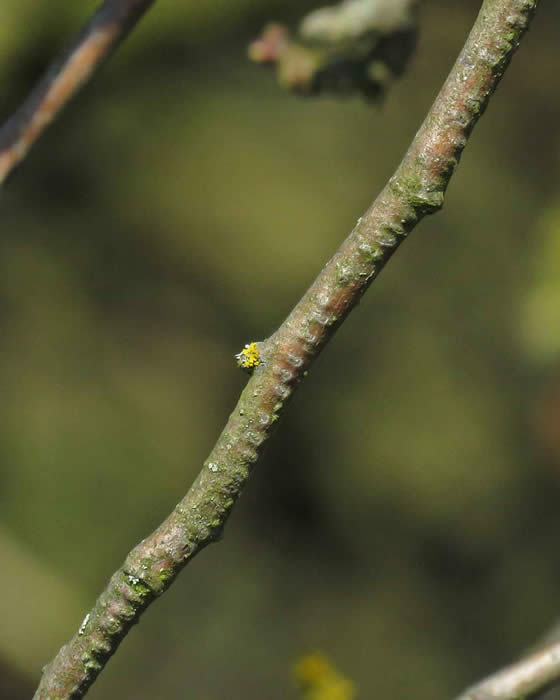
Willow Emerald scars on apple (Derek Longe, April 2018); the apple tree by the railway line, August 2018.
Finding a new record for the UK prompted us to encourage Ann Greenizan and Richard Mason to submit records from Sutton and Catfield Fens.
BOG MYRTLE
Richard Mason observed on 5th March 2018 approximately 30 Willow Emerald scars on one c.1cm diameter, 50cm long stem of Bog Myrtle Myrica gale overhanging a deep peat ditch at Butterfly Conservation’s Catfield Fen nature reserve, which is managed by the RSPB.
Richard writes: “I have been seeing scars on Willow and Alder in abundance across Sutton Fen and Catfield Fen and I have checked a handful of Bog Myrtle stems with no success. On Monday, I noticed scars on a few Alder stems and thought I should have a quick check of the Myrtle nearby. I checked approximately five stems with no scars before finding one with scars, I stopped searching then. Along that ditch there are many hundreds of Myrtle stems (maybe thousands) and I am confident that a proper search would find many more scars. It would be very lucky if I found them so quickly if they weren't present in some quantity.”
Photographs by Ann Greenizan were sent with the record to Adrian Parr. He comments: “This is an interesting observation, and the first report from Bog Myrtle that I've heard about in the UK. There are, however, several reports of egg-laying into this species on the continent.”
He went on to say: “The Willow Emerald clearly has the ability to use a lot of trees/shrubs/herbs for egg-laying. There do seem to be preferences - with Willow, Alder and Ash clearly being preferred, but if needs be then a whole host of other species can also be used. Indeed, I recently saw a photo of a pair trying to oviposit into a steel bolt at the water's edge, so clearly there are other egg-laying cues beyond biological ones!!”
HOLLY
Ann Greenizan found scarring on a Holly Ilex aquifolium at RSPB Sutton Fen on 28th March 2018 (photos, right).
Commenting on the records and photos, Adrian Parr said: “What interesting pictures! A quick check of the literature failed to find mention of Holly being used for egg-laying, and some photos almost suggest a fungus of some sort. However, the white marks seem to often have a central hole, are suspiciously regularly placed, and do sometimes seem to be bordered by swellings where the Willow Emerald eggs would be. My feeling is thus that these are indeed Willow Emerald egg scars, but that the Holly has reacted to the egg-laying in some way. There thus seems to be gall formation around the wound site rather than around the eggs, and the bark has remained quite compressed. Maybe this is an unfavourable reaction, which might explain why Holly isn't often used.”
Naturally we are rather pleased to have found three new records for Britain. Could there be more trees and shrubs used by Willow Emeralds? It seems likely, with the main constraint being where they grow: it has to be young growth, open enough for the adult female damselfly to clasp and with water directly underneath for emerging larvae to drop into. We encourage others to become Willow Emerald detectives: the BDS website 'willow emerald watch' is a good place to start.
ORNAMENTAL (WHITE) DOGWOOD AND LIME, AUGUST 2018
The above is all as published in the Norfolk Natterjack. More recent finds are Willow Emerald egg-laying scars on white dogwood Cornus alba (details below) and common lime Tilia x vulgaris (see right hand column).
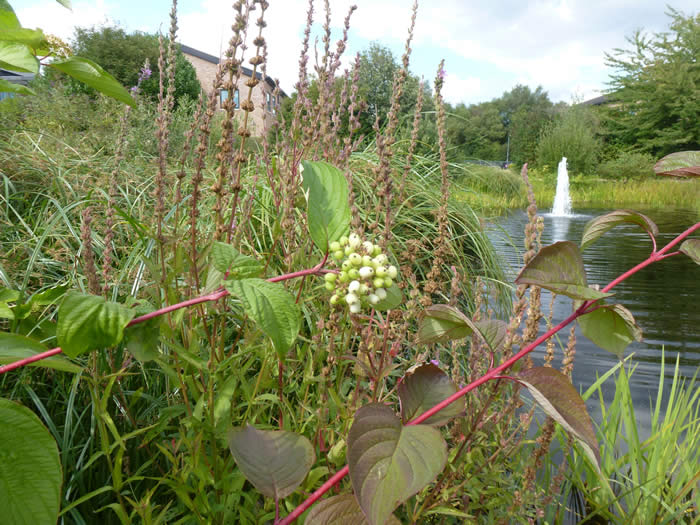 |
The scars on the planted, non-native white dogwood were found by Chris Durdin on 25 August 2018 at the pond at the Terrace Café on Broadland Business Park, Thorpe St Andrew, Norwich. Cornus alba by Terrace Café pond. |
Adrian Parr from BDS said: "Yes, as far as I'm aware, Cornus alba is indeed a new host species for the UK, though on the continent there are several reports from the related Cornus sanguinea [that's wild dogwood]. It's quite an impressive list that people are now putting together! The suggestion that it's this year's growth is also interesting - I believe Willow Emeralds favour young growth, but wood that has passed its major growth spurt. Your pictures would indeed fit in with this."
There is now a second record for this species: I found more scars on white dogwood at Fairhaven Gardens, South Walsham on 30 September.
Willow Emerald egg-laying scars on Cornus alba, 25 August 2018.
SWEET CHESTNUT, AUGUST 2019
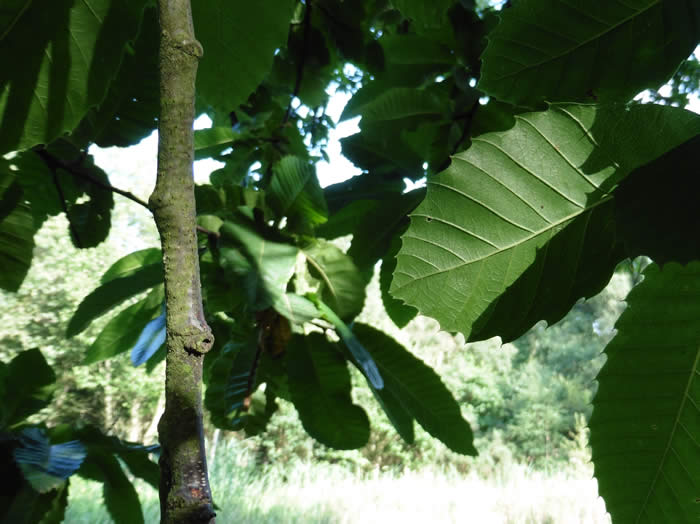
Willow emerald egg-laying scars on sweet chestnut, Kelling Heath conservation pond, 8 Aug 2019.
The above discovery is - as the caption above says - scars on sweet chestnut Castanea sativa at Kelling Heath Holiday Park, Norfolk.
Adrian Parr from BDS said: "As far as my records go, this is indeed the first time Sweet Chestnut has been recorded as an oviposition 'host' in the UK - in fact there don't seem to be (m)any literature reports from the Continent, either. So congratulations on your sharp-eyed find!
"The list of species used continues to grow at a steady rate, and I've recently had some interesting records relating to more herbaceous species (e.g. Prickly Lettuce). Clearly Willow Emeralds are pretty flexible in their choice of oviposition site if the preferred species aren't available, though the precise breeding success often remains unknown."
HEMP AGRIMONY
Adrian Parr’s mention of herbaceous species proved spot on. When I suggested an article on the latest three discoveries to Francis Farrow, the editor of The Norfolk Natterjack, bulletin of the Norfolk & Norwich Naturalists' Society, Francis described how on Beeston Common this autumn he found three pairs of Willow Emeralds on Hemp Agrimony Eupatorium cannabinum. He photographed these on 26 September 2019 and then the unusual looking scars, again on Hemp Agrimony, on 27 September 2019.
Adrian Parr from BDS said: “Hemp Agrimony is definitely a new host species for the UK, and I can't find any mention of it in the European literature either. So it's certainly a good find! The scars are intriguing in that they look very atypical; normally female Willow Emeralds produce entry holes rather than slits, and the areas where the eggs lie are usually more obvious. Perhaps the nature of the stems has affected the normal oviposition process? The photo of the egg-laying pairs seems to show that they're very happy, though!”
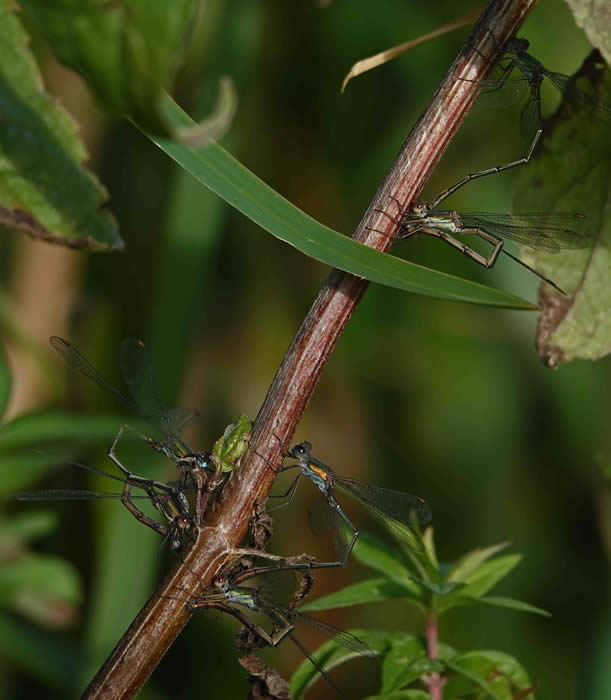
Willow emeralds on hemp agrimony (Francis Farrow)
SYCAMORE
In May 2020, Honeyguide Ann Greenisan found willow emerald egg-laying scars on sycamore twigs over a ditch at Surlingham, Norfolk. She sent photos to Adrian Parr of BDS, who says:
"The tracts on the stems are clearly also willow emerald egg scars. So that's another new 'host' plant for the UK - well done! On the continent, the species has, however, already been recorded egg-laying into several different Acer species, including sycamore.
"As well as the new 'host', your photos are interesting from another perspective as well. Normally when the female willow emerald inserts her ovipositor she lays separate batches of 1-3 eggs on each side of the insertion point. That's what gives the scar tract its characteristic jizz. However if you look closely, you can see a few places on your photo where eggs have been laid on one side of the insertion point only. Perhaps the twig was a bit tough?"


